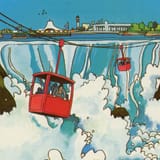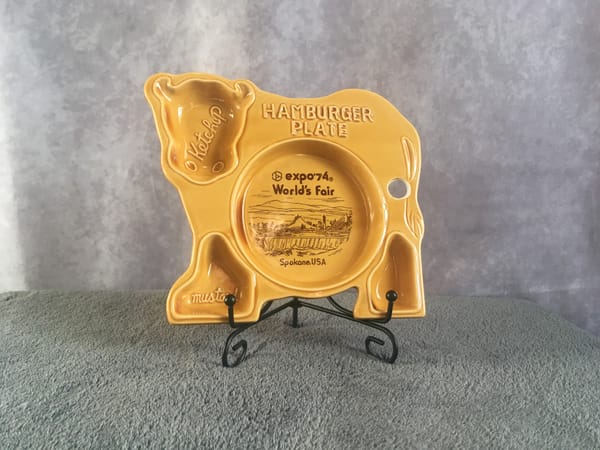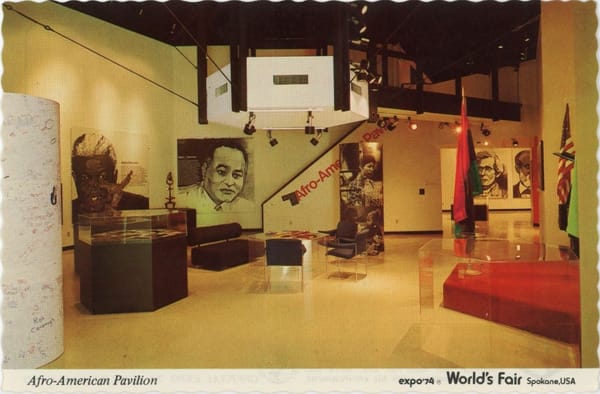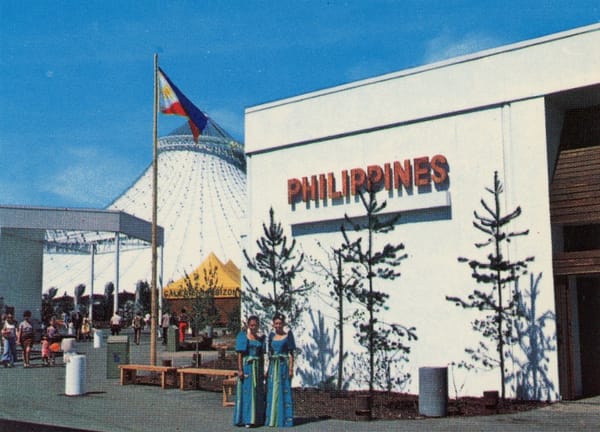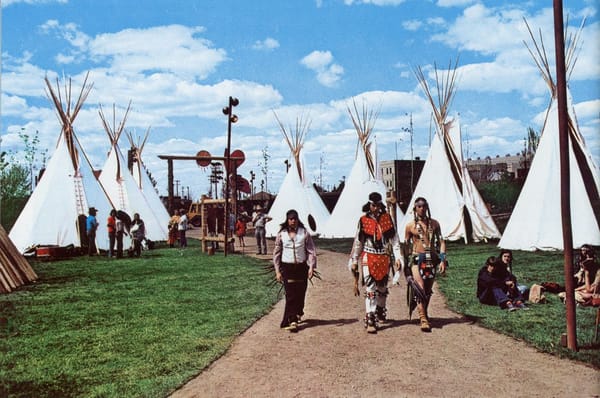June 22-June 28: The prince, the streakers, the bride, and the chief.
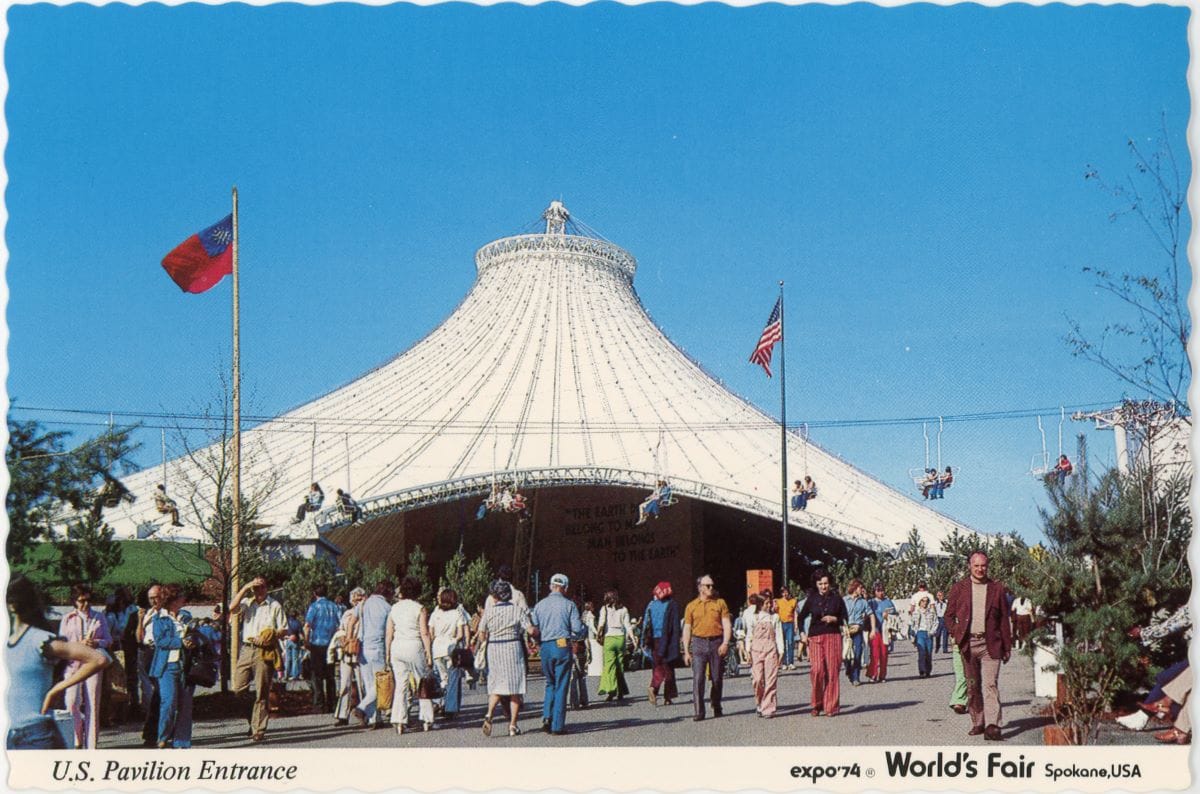
As an avid but selective collector of Expo '74 merchandise, I was delighted to find this article from June 27, 1974, predicting the value of Expo souvenirs in the year 2024.(1) It feels like they're talking to me!
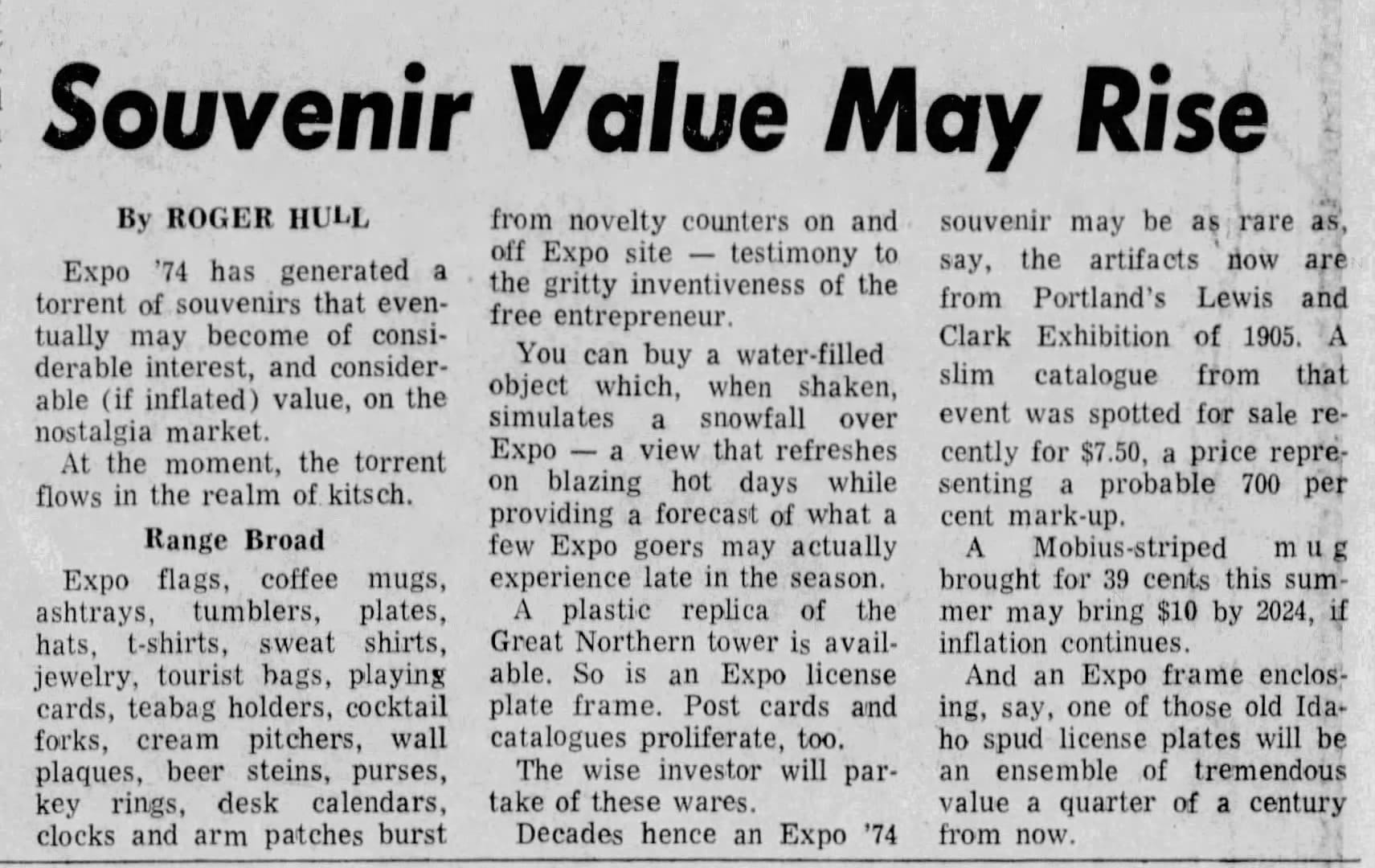
I particularly like the specific prediction that "A Mobius-striped mug brought [sic] for 39 cents this summer may bring $10 by 2024, if inflation continues." One of those very mugs is currently for sale on eBay for $14.99 plus $10.81 in shipping. It would probably be less if it had been posted last year, but the fiftieth anniversary seems to have prompted more people to dig into their attics for their leftover Expo stuff, and people are pricing their stuff more optimistically today than they might have done a few years ago.
Most Expo '74 souvenirs in 2024 are not rare. Souvenirs that were small and easy to store flat seem to have the best chance of surviving to 2024: stamps, postcards, brochures, maps, pennants, etc. Souvenirs that are decorative and relatively sturdy also have good odds of being around today: plates, cups, mugs, collectible spoons, and the ubiquitous ashtrays. On the other hand, cloth wearable items like the t-shirts and sweatshirts mentioned in the article above are vanishingly rare. I assume most of them got worn and then worn out.
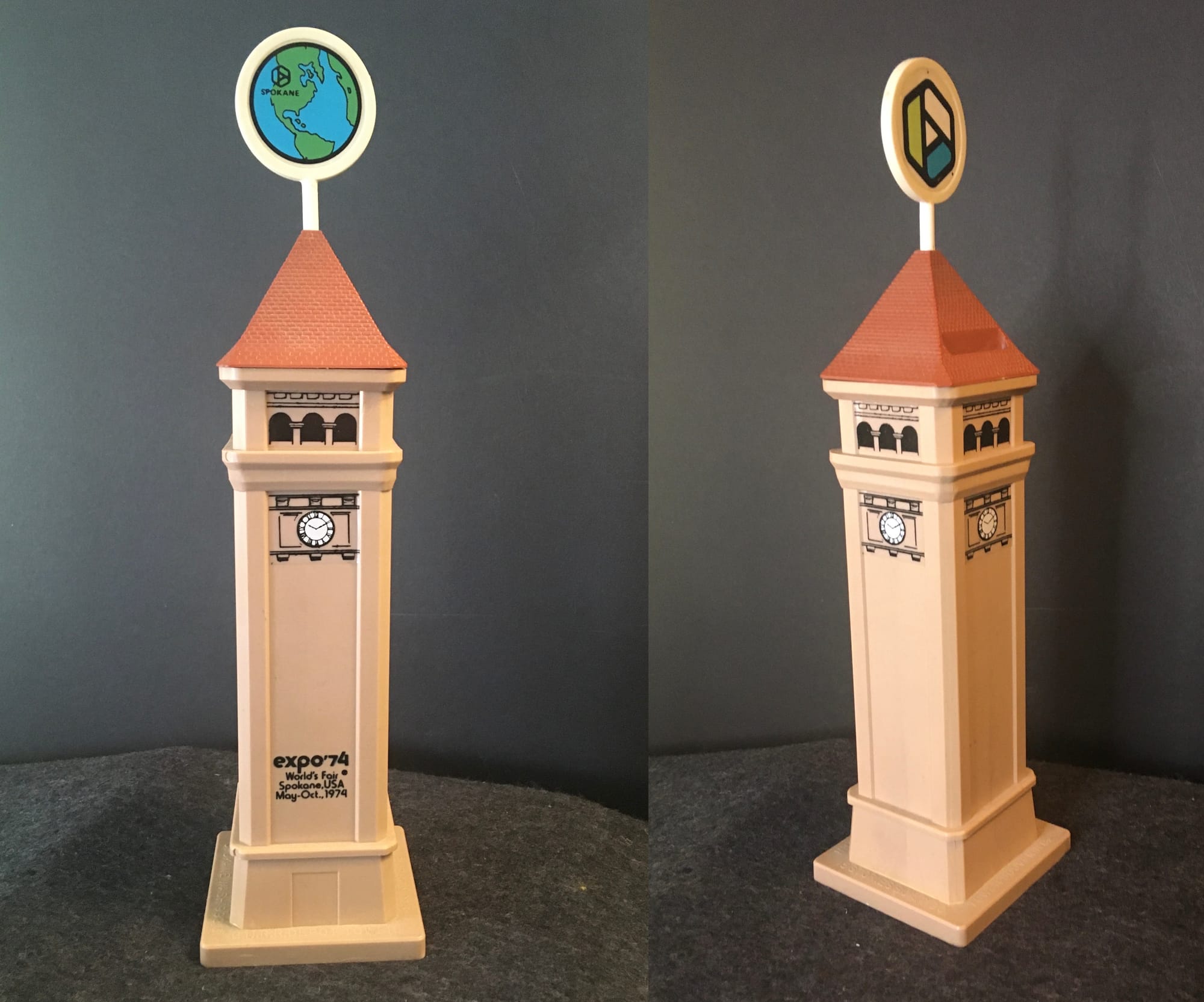
Native Americans' Earth this week featured the Spokanes and the Kahclamet Dancers, a Yakima group.(2) Members of the Spokane Tribe demonstrated corn husk weaving, beading, hide tanning, and dancing. They also built a smokehouse and held a re-enactment of a traditional Spokane wedding (see Thursday for more).
It was Scandinavian Week at Folklife, timed to coincide with the summer solstice and the traditional Midsommerfest.(3) While many cultural weeks at Folklife were presented by American descendants of immigrants from various nations, Scandinavian Week also brought in about 30 traditional musicians and dancers from Norway, Finland, and Sweden.(4) Pererik Moraeus, a Swedish fiddler, observed that visitors to Folklife were even more enthusiastic about dancing than some of his audiences back home: "They love to dance to the more difficult tunes and that makes it more fun for the musicians." Other Scandinavian Week activities included wood-carving, candle-making, bobbin lace-making, rug-making, and spinning.(5)
Expo was also visited this week by the Crown Prince of Tonga, known as 'Tupoutoʻa at this time in his life.(6) It appears to have been a low-key visit: "The prince and his State Department escort slipped into town late one night. They spent a good part of the next day at Expo '74 quietly touring the site and left early the next morning by plane for San Francisco." The prince also attended a dinner party at Hayden Lake. He was reported to have "particularly enjoyed the art exhibit at Expo '74 and the beauty of the lake area in Idaho."
WEEKLY EVENTS
On Saturday, June 22, there were at least 600 Expo visitors who were probably very glad that the fair was designed without steep hills or stairs. Their legs were tired out from a five-day cycling trip across the state from Issaquah.(7) The pack of cyclists arrived in Spokane at around noon on Friday and camped at Highbridge Park to recover before visiting the fair on Saturday.
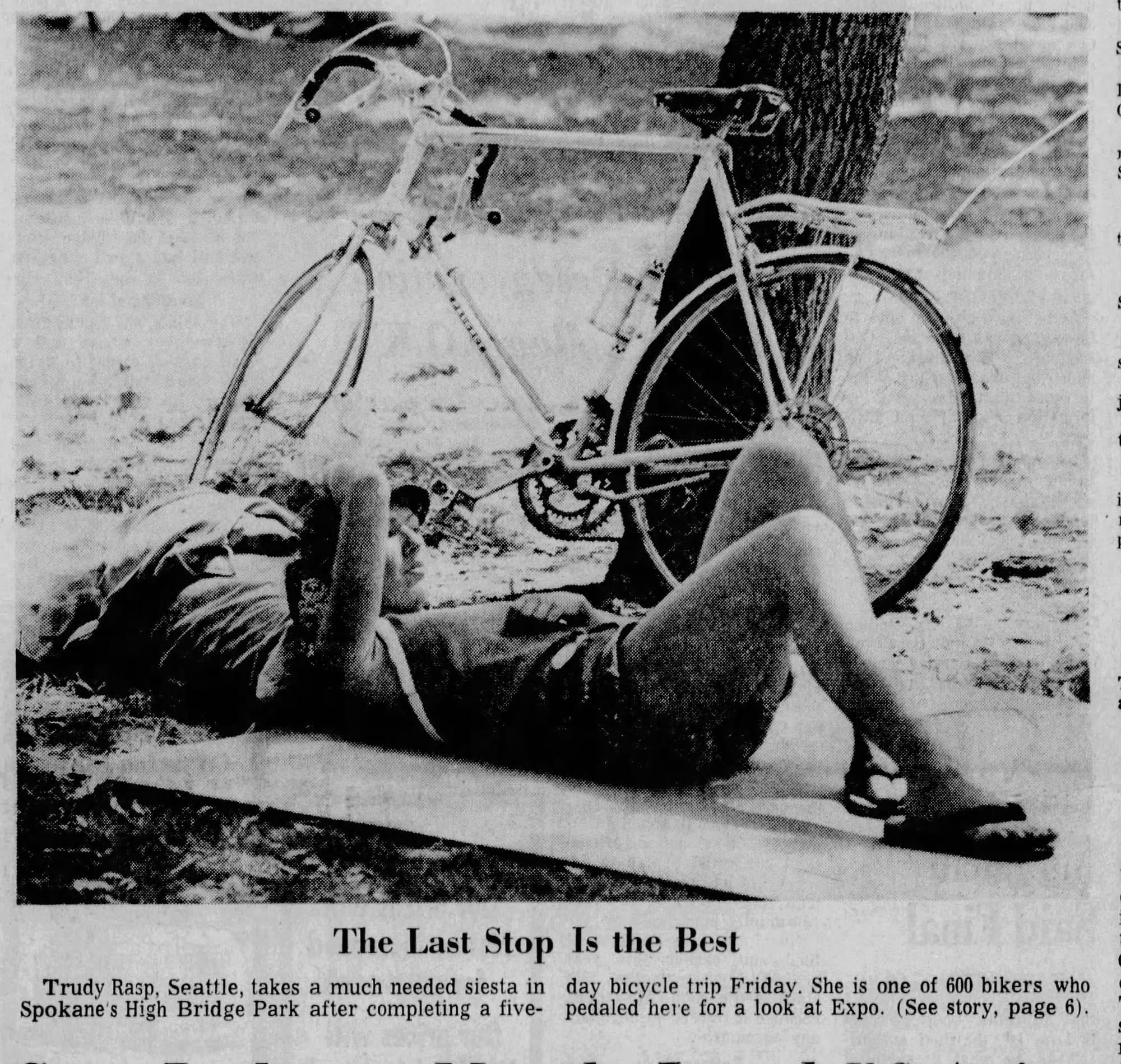
Saturday was also the Honor Day for Montana. Montana Governor Thomas L. Judge and many other Montanans were present for the day's ceremonies, which included the governor reading an environmental story over a specially-composed piece performed by the Missoula, Montana Grade School All-City Concert Band.(8)
On Sunday, June 23, the Scandinavians marched the traditional "Majstang" evergreen pole through the Expo fairgrounds.(3). Sunday was also North Central High School reunion day at the fair.(9) From the class of 1912 to the class of 1970, thousands of NC graduates gathered at the fair to enjoy catching up with their classmates.
After getting delayed by the breakdown of an equipment truck, Grand Funk played their make-up show at the Coliseum on Monday, June 24. Sue English of the Spokane Chronicle enjoyed the show, although she didn't feel like the sound mixing worked well with the Coliseum space.(10) On the other hand, Paul Bhatia of the Spokesman-Review was clearly disappointed by the show, and accused the band of having become "bubble gum" and mainstream.(11) Both reviewers noted the appearance of three male streakers during the concert, although Bhatia dismissed them as being planted by the band. We may never know, but 1974 was certainly the cultural high-water mark for the streaking fad.
Tuesday, June 25 was Ephrata Festival Day at the fair.(12) The Royal Shakespeare Theater performed at the Opera House, but refused to use the sound system, so nobody was able to hear them.(13) One final chapter was added to the Grand Funk saga, as reports indicated that they had left their dressing room covered in ketchup and mustard. That is very annoying, but rock bands have covered their dressing rooms in far worse. I think we got off easy.
The fairgrounds were brightened on Wednesday, June 26 by the presence of Los Lupeños de San José, a Mexican folklórico dance company that was new in 1974 but is still going strong today. They were at Expo as part of San Jose Day celebrations.(14)
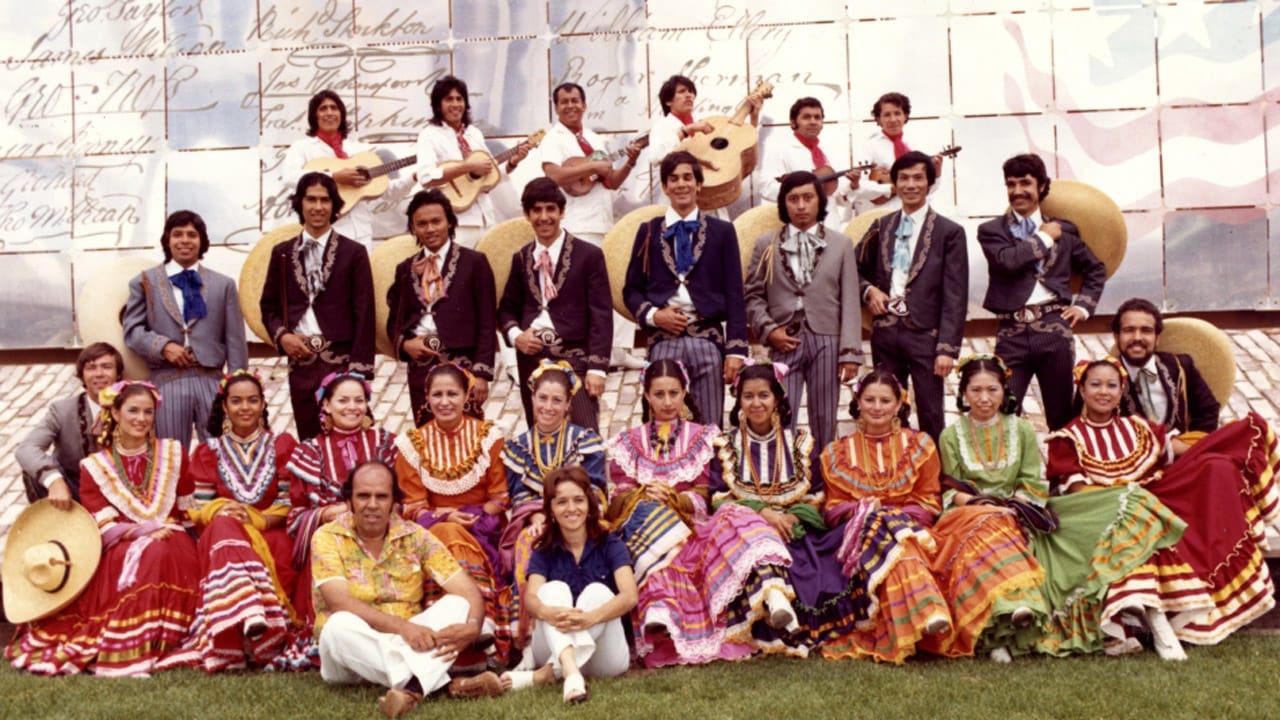
On the evening of Thursday, June 27, two representatives from the Spokane Tribe of Indians enacted a traditional Spokane wedding.(15)
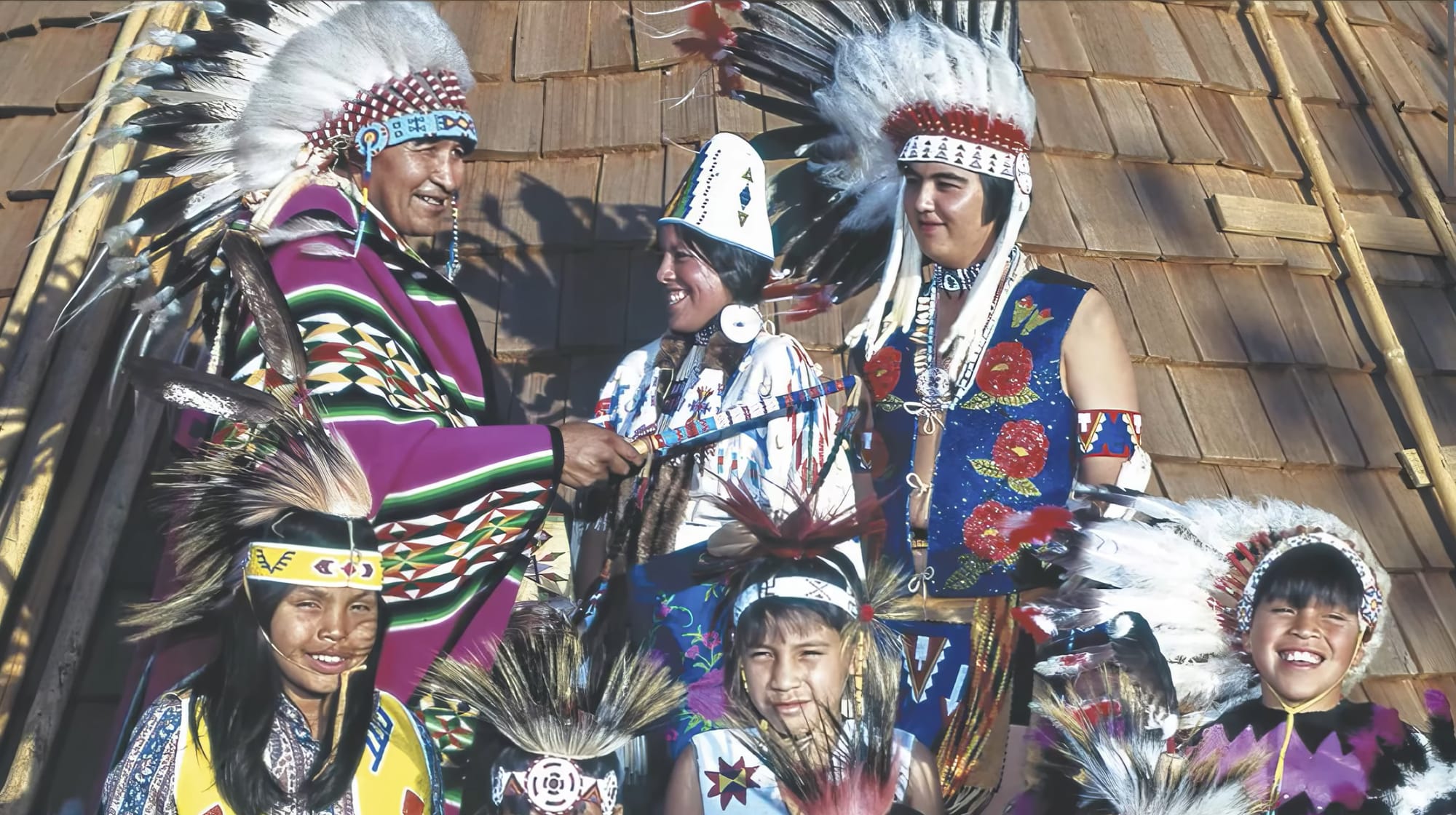
Carol Sterns played the bride and Mike Sayler played the groom. Carol recently participated in the KSPS documentary about Expo '74 and talked about the message of that wedding enactment:
If we're cut, we bleed just like you. We, too, fall in love and want to join with another person and have a family, and this is how we do it.
You can see her interview and more in the documentary, embedded below. I have cued it up to the relevant part at 35:59.
Thursday also saw the Modern Jazz Quartet with the Spokane Symphony at the Opera House.(16) The Vanishing Species Exhibit received a newborn male fawn presented by the Spokane Indian Tribal Council, as well as three skunks from an unnamed source.(17)
On Friday, June 28, the Opera House hosted the performance of the Nord-Pacific Sängerbund, a collection of traditional German musical groups from across the Pacific Northwest.(16) The performers appearing at Expo included a brass band, an orchestra, and 300 singers. The Sängerbund had coordinated its Sängerfest, typically held on a biannual or triannual basis, to appear at Expo '74, but the Sängerfest was a tradition that originated many years earlier and appeared to still be going as of 2020.
Friday was also Virginia Day at the fair, and Virginia's Governor Mills E. Godwin, Jr. was present for the ceremonies.(18) Godwin was the first governor in the history of the United States to be elected as both a Democrat (for his first term, 1966-1970) and a Republican (for his second term, 1974-1978).
ATTENDANCE
Through Friday night, total Expo attendance reached 1,702,950 visitors.(19)
PAVILION/EXHIBIT HIGHLIGHT: THE UNITED STATES PAVILION
Okay, it's time for me to stop avoiding one of the big two pavilions that intimidate me (the other is the USSR pavilion). But to make things less overwhelming, I'm only going to talk about one part of the United States Pavilion today... the "Earth Does Not Belong To Man, Man Belongs To The Earth" message that was interwoven throughout the U.S. presentation. It was quoted on the back page of the U.S. Pavilion brochure:
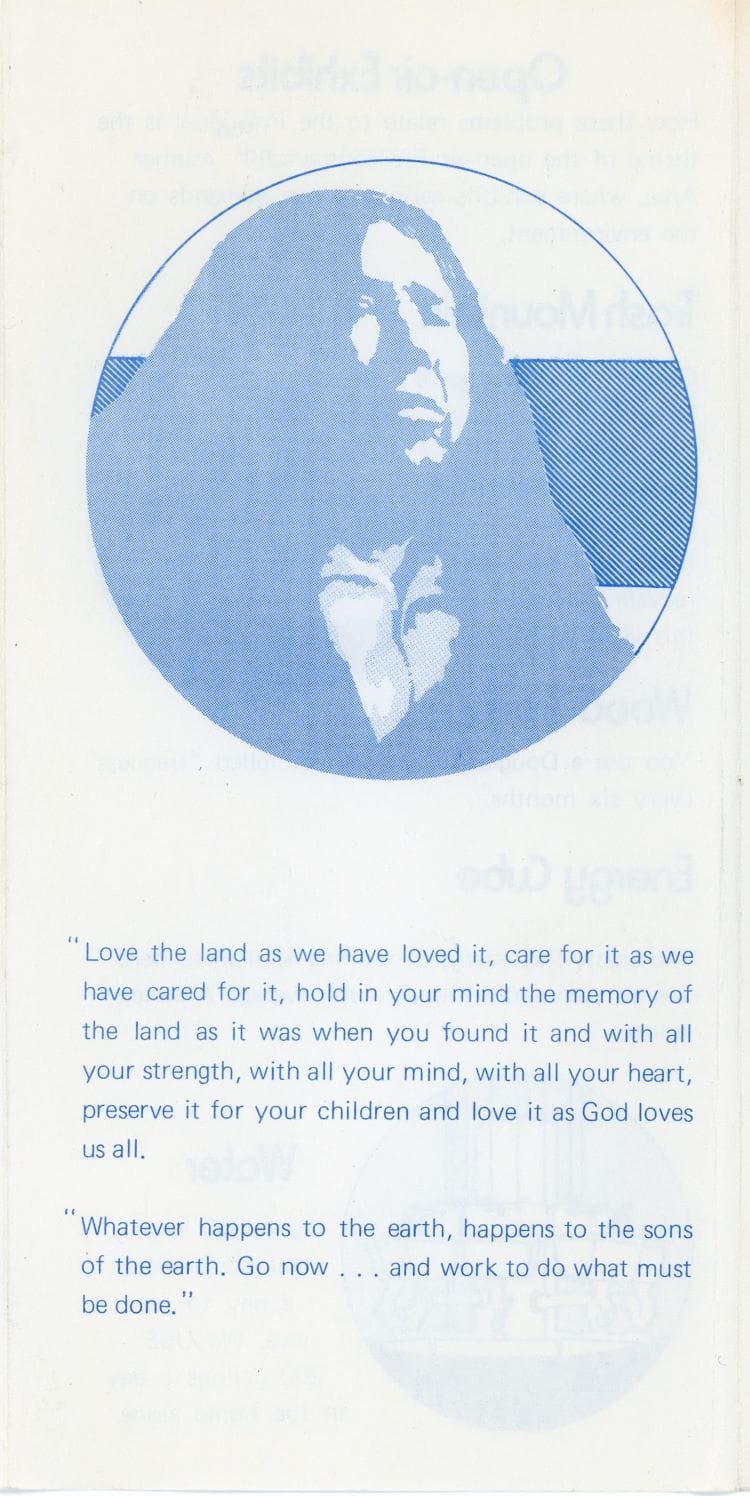
In the US Pavilion’s inner courtyard, a wall towered over fair visitors. On it were the words, “THE EARTH DOES NOT BELONG TO MAN, MAN BELONGS TO THE EARTH.” Several totem poles were arranged in front of the wall.
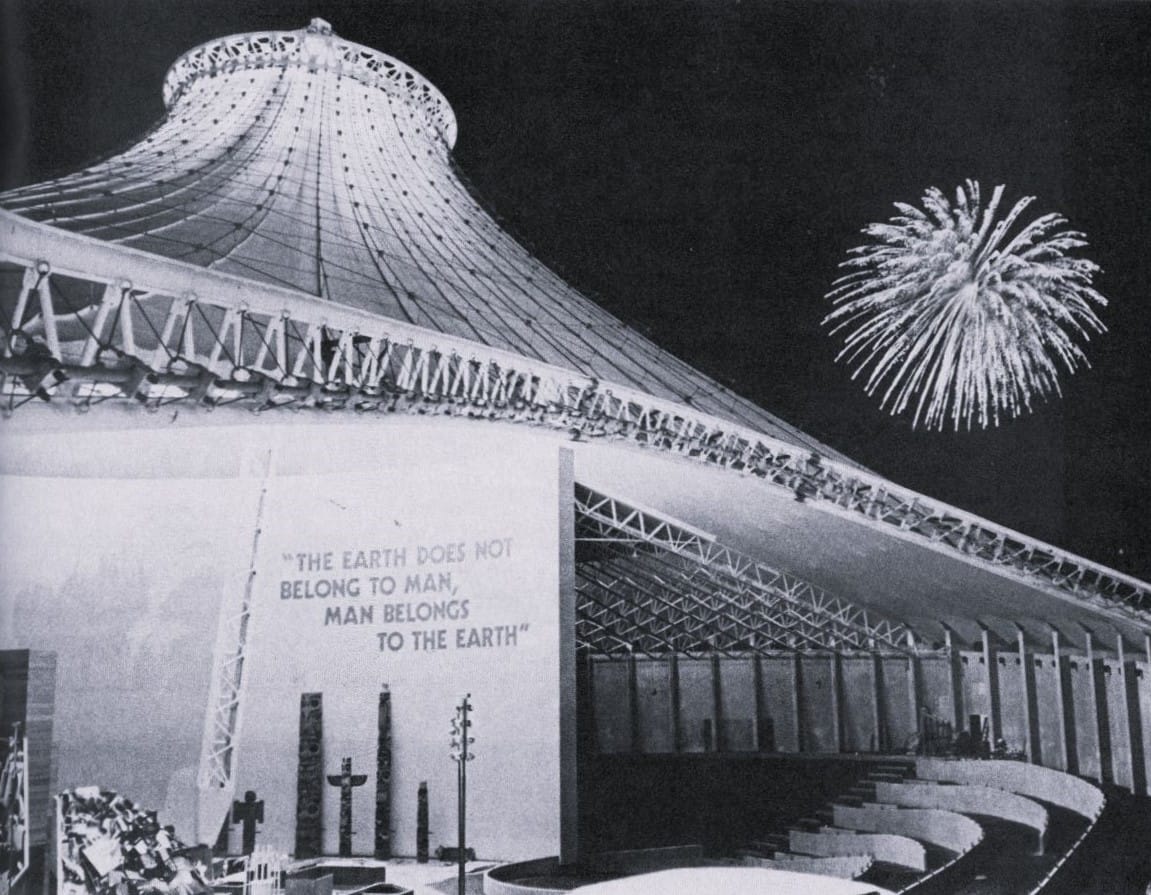
The IMAX film made for the U.S. Pavilion was titled “Man Belongs To The Earth.” In American Cinematographer magazine, the title was explained this way:
The title of this film is drawn from a speech made by Chief Seattle of the Suquamish Tribe when the Federal Government offered to purchase his tribal lands in 1854. The words were chosen because they epitomize the attitude of our country’s first environmentalists, the American Indians, and suggest that we should return to this way of thinking.
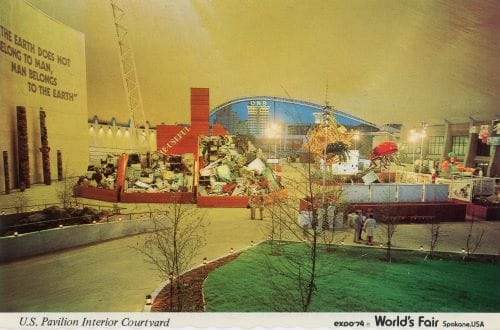
In reality, Chief Seattle did make a speech to government officials at a meeting in or around 1854, and that is about as much of this story as can be reasonably verified. In 1887, Henry A. Smith wrote down what he believed Chief Seattle to have said 33 years earlier, which probably would have been translated into English from Lushotseed by way of Chinuk Wawa. This secondhand remembered version would be modified and reprinted many times over the years, often with tweaks to make it better suit the message intended by the person quoting it.
In 1972, an environmentalist movie called Home needed a promotional poster, so screenwriter Ted Perry used Chief Seattle’s speech as a starting point for a fictional message from an unspecified fictional Native American. Perry added extensive environmentalist material that was nowhere to be found in the original version written down by Smith. The material added by Perry in 1972 included the statement, “the Earth does not belong to man, man belongs to the Earth.” Later, the film’s producer added more religious messaging to the speech (the film was sponsored by the Southern Baptist Radio and Television Commission) and removed the attribution to Perry, creating the impression that this new “environmental version” was what Chief Seattle had said.
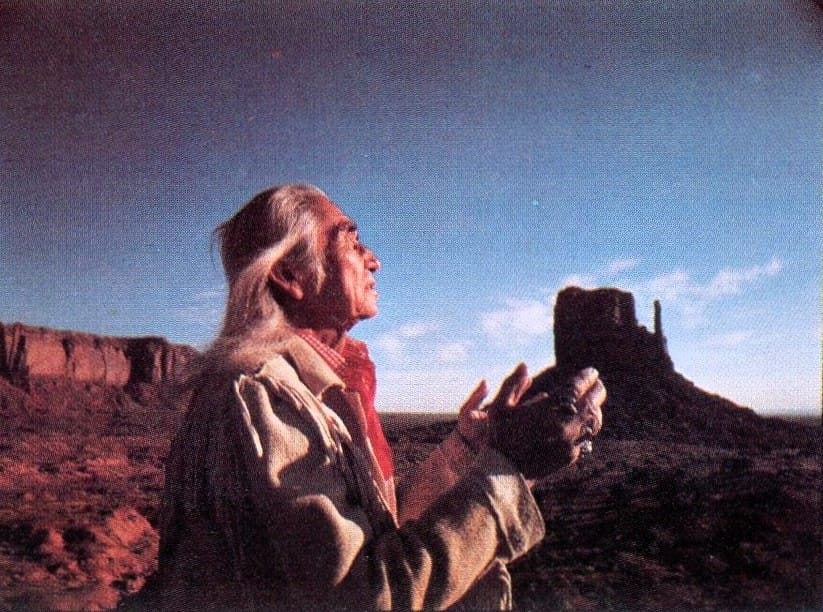
In other words, Expo '74 attendees were being urged to return to a “way of thinking” that had been made up two years earlier by a white screenwriter named Ted. Although it is easier to discover that fact today with the help of the internet, a bit of help from a contemporary historian would have made it clear that this version of the speech was a very recent addition to the Chief Seattle canon. As noted in the National Archives page on the speech:
The purported letter by Chief Seattle to President Pierce is very likely spurious. Among other charges, it denounces the White Man's propensity for shooting buffaloes from the windows of the ‘Iron Horse’—a remarkable observation by Seattle, who never in his lifetime left the land west of the Cascade Mountains and thus never saw a railroad and may never have seen a buffalo, either.
“The earth does not belong to man, man belongs to the earth” has taken on a life of its own, and you can still buy posters, t-shirts, stickers, mugs, and all other sorts of merchandise with the motto today. As there is only one known photo of Chief Seattle, and it is apparently not sufficiently sexy, many of these tchotchkes illustrate the “quote” with portraits of generic Native men in warbonnets or (in at least one case) Sitting Bull. To better suit modern perceptions of the word “man” as less than universal, some sellers have reworked the quote to be “Earth does not belong to us, we belong to the Earth.” The tradition of inventing words to put in Chief Seattle’s mouth is likely to carry on for many decades to come, evolving to suit the agenda of anyone who cares to borrow it. Fifty years from now, perhaps Chief Seattle’s “speech“ will be warning us that Mars does not belong to humans, humans belong to Mars.

The definitive resource on this topic is Eli Gifford’s 2015 book, “The Many Speeches of Chief Seattle (Seathl): The Manipulation of the Record on Behalf of Religious, Political and Environmental Causes.” It includes extensive sources and thoughtful analysis. It also includes a foreword from screenwriter Ted Perry in which he confirms his authorship of the original version of the “environmental speech" that was later taken out of context and attributed to Chief Seattle.
Chief Seattle never said “Earth does not belong to man, man belongs to the Earth.” But at Expo ‘74, “on the way out of the [U.S.] pavilion, the visitor could view a 'talking mannequin' of Chief Seattle, proclaiming that 'the earth does not belong to man.'"(20) The mannequin “talked” through an audio recording that played nearby while a video was projected onto its face. It is hard to think of a more apt metaphor for how the environmental movement of the 1970s, and the U.S. Pavilion by extension, put words in Chief Seattle's mouth.
Until next time!
Past Topics:
REFERENCES AND FOOTNOTES
- Hull, Roger. (June 27, 1974). "Souvenir Value May Rise." Spokane Chronicle, p. 4. Via Newspapers.com: https://www.newspapers.com/article/spokane-chronicle-souvenir-value-may-ris/149510106/
- "Spokanes, Dance Unit Due At Expo." (June 25, 1974). Spokesman-Review, p. 31. Via Newspapers.com: https://www.newspapers.com/article/the-spokesman-review-spokanes-dance-uni/149509346/
- Cross, Alden. (June 24, 1974). "Fairgoers Turn Out For Midsommerfest." Spokesman-Review, p. 6. Via Newspapers.com: https://www.newspapers.com/article/the-spokesman-review-fairgoers-turn-out/149508366/
- "Rapport Blooms At Scandinavian Fete." (June 27, 1974). Spokesman-Review, p. 15. Via Newspapers.com: https://www.newspapers.com/article/the-spokesman-review-rapport-blooms-at-s/149510276/
- "Look Out For Trolls At Expo." (June 24, 1974). Spokane Chronicle, p. 33. Via Newspapers.com: https://www.newspapers.com/article/spokane-chronicle-look-out-for-trolls-at/149508701/
- Parsons, O.J. (June 27, 1974). "Potpourri." Spokesman Review, p. 20. Via Newspapers.com: https://www.newspapers.com/article/the-spokesman-review-potpourri/149510434/
- Bunning, Paul. (June 22, 1974.) "600 Bikers From Coast Whiz In." Spokesman-Review, p. 15. Via Newspapers.com: https://www.newspapers.com/article/the-spokesman-review-600-bikers-from-coa/149507586/
- "Fair Honors Big Sky Folk." (June 23, 1974). Spokesman-Review, p. 14. Via Newspapers.com: https://www.newspapers.com/article/the-spokesman-review-fair-honors-big-sky/149508248/
- Barnes, Hazel. (June 22, 1974). "NC Graduates Gather." Spokane Chronicle, p. 3. Via Newspapers.com: https://www.newspapers.com/article/spokane-chronicle-nc-graduates-gather/149507819/
- English, Sue. (June 25, 1974). "Grand Funk Show Pleases – Finally." Spokane Chronicle, p. 12. Via Newspapers.com: https://www.newspapers.com/article/spokane-chronicle-grand-funk-show-please/149465433/
- Bhatia, Pete. (June 26, 1974). "Grand Funk's Promise Lost In Metamorphosis." Spokesman-Review, p. 5. Via Newspapers.com: https://www.newspapers.com/article/the-spokesman-review-grand-funks-promis/149906193/
- "Crowds Flock To Fair Site To Celebrate Ephrata Day." (June 26, 1974). Spokesman-Review, p. 7. Via Newspapers.com: https://www.newspapers.com/article/the-spokesman-review-crowds-flock-to-fai/149509869/
- "Expo Today: Fair's Timetable (June 26)." (June 26, 1974). Spokesman-Review, p. 1. Via Newspapers.com: https://www.newspapers.com/article/the-spokesman-review-expo-today-fairs/149509721/
- "San Jose Day Marked." (June 27, 1974). Spokesman-Review, p. 6. Via Newspapers.com: https://www.newspapers.com/article/the-spokesman-review-san-jose-day-marked/149510163/
- "Tribe To Portray Wedding Ritual." (June 27, 1974). Spokesman-Review, p. 15. Via Newspapers.com: https://www.newspapers.com/article/the-spokesman-review-tribe-to-portray-we/149510294/
- "Many Programs Planned At Expo This Week." (June 25, 1974). Spokesman-Review, p. 38. Via Newspapers.com: https://www.newspapers.com/article/the-spokesman-review-many-programs-plann/149508853/
- I need to dig more into what the Vanishing Species Exhibit was all about, because most of the animals mentioned as being part of the exhibit do not seem to have been particularly endangered.
- "Expo Parade of Governors Is Resuming." (June 27, 1974). Spokane Chronicle, p. 4. Via Newspapers.com: https://www.newspapers.com/article/spokane-chronicle-expo-parade-of-governo/149510086/
- "Expo Today: Fair's Timetable (June 30)." (June 30, 1974). Spokesman-Review, p. 1. Via Newspapers.com: https://www.newspapers.com/article/the-spokesman-review-expo-today-fairs/149511073/
- Youngs, J. W. T. (1996). The Fair and the Falls: Spokane's Expo '74. Eastern Washington University Press, p. 487.
